
Summary
This is only for planted aquariums. If you have a fish only aquarium ignore this article.
It is very important to plant a planted aquarium with a LOT of plants. There needs to be a plant of some sort every three inches. To illustrate, a 20 gallon aquarium is 24 x 12 x 16. This will require 5×3 or fifteen plants evenly spaced every three inches. Plants which are thriving produce some sort of a “cloud” on their leaves and in the immediate vicinity which keeps algae at bay. But the whole aquarium needs to be covered in plants or it doesn’t work.
If you have a larger tank this can get a bit daunting. A 75 gallon four foot by foot and a half aquarium will require 75 plants. At $8 a plant that if $520, which is a bit steep. The best way to avoid this cost is to grow your own plants outside the aquarium and only plant them when you have a lot of them. More on propagating plants in this link:
15.12. Propagating Plants
If you are a real nerd read on:
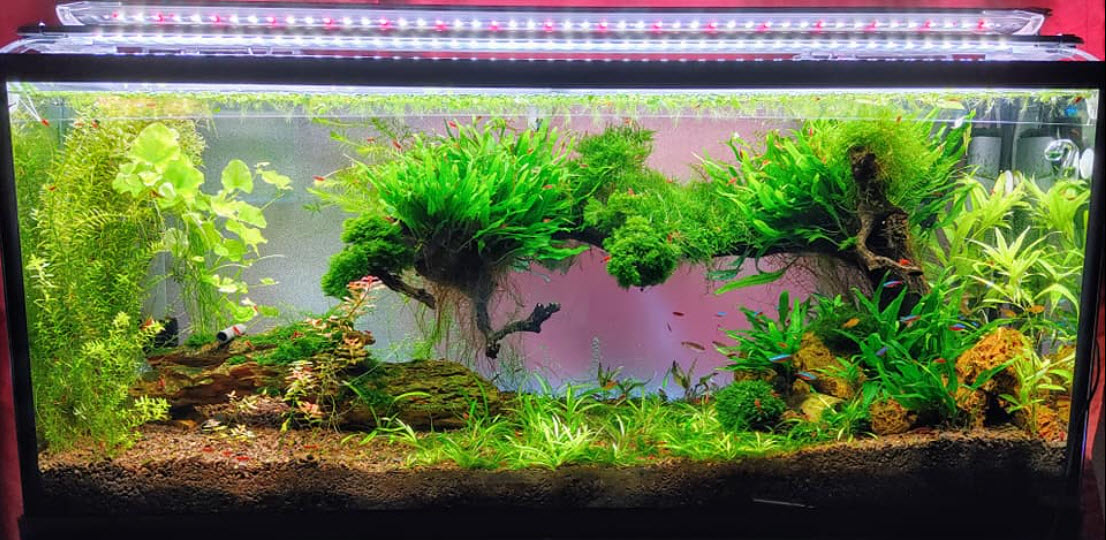
The Algae War in Depth
There is a process called negative allelopathy whereby plants wage warfare on each other. The vascular plants (plants with stems and leaves) have some plant poisons which they use. Algae also use plant poisons but also can kill simply by smothering. Diana Walstad went into this in some detail in her book: “The Ecology of the Planted Aquarium”
Some argue that negative allelopathy does not play a major role in the aquarium (“Allelopathy – Chemical Warfare Between Aquatic Plants” Dr. Ole-Pedersen). Dr. Ole-Pedersen argues that all the examples shown by Diana Walstad are only examples where the vascular plants grew well with shortage of a given nutrient (including light and carbon dioxide). But this ignores the hundreds of aquariums which use the EI fertilization method to create stunning planted aquariums free of algae.
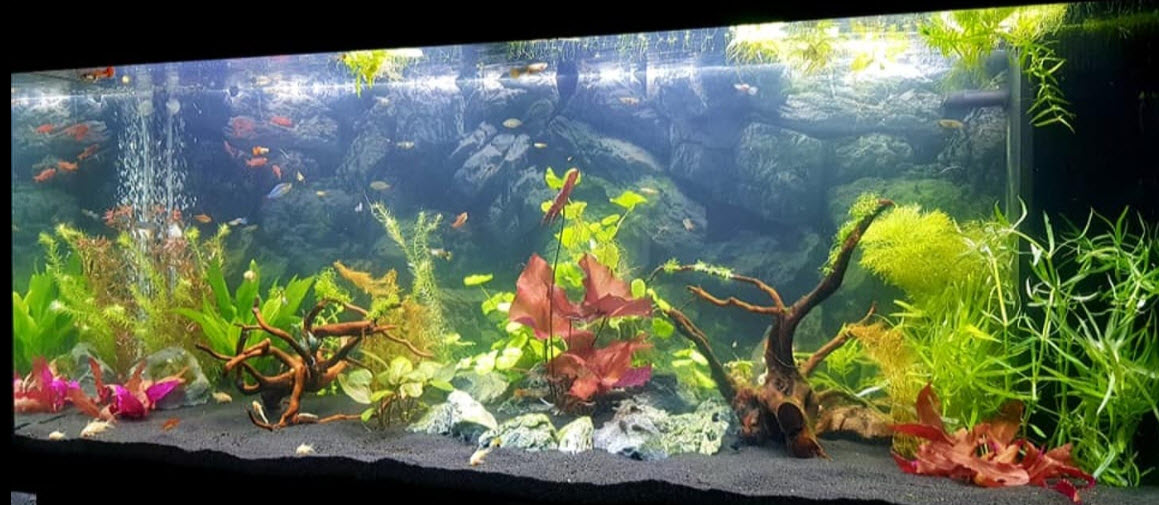
With the EI method one adds a large amount of everything to an aquarium which is very heavily planted with vascular plants. The vascular plants love it and grow well while the algae, which like the same things as the vascular plants, do not grow. So how do thriving vascular plants, where there is no shortage of anything, manage to keep algae at bay? With the EI method you typically have all the nutrients being added every other day and heavy lighting and heavy carbon dioxide injection. So where is the shortage?
And Dr. Tom Barr, the originator of the EI method, notes that his method doesn’t work well if the aquarium is only sparsely planted. He recommends very heavy planting of the aquarium at the time the aquarium is set up. Negative allelopathy nicely explains this.
And many have noticed that an outbreak of something like green spot algae or blackbeard algae can occur where only one species of vascular plant is affected. If vascular plants have different toxins, this anomaly is also neatly explained by negative allelopathy.

One has to be conscious of the way chemicals diffuse in water. The concentration of a chemical added to water in an aquarium can be described as the concentration being proportional to somewhere between the distance cubed to the distance to the sixth power. The exact number depends on the water flow in the aquarium. So, using the conservative cubed number, if the concentration is 1,000 at one millimeter, it is now 125 at 2 millimeter, 16 at 4 millimeter and 1 at ten millimeters. This rapid drop off nicely explains why Dr. Barr recommends lots of vascular plants carpeting the whole aquarium.
To see how this works a sequence of photos depicting the making of a planted aquarium is in order:
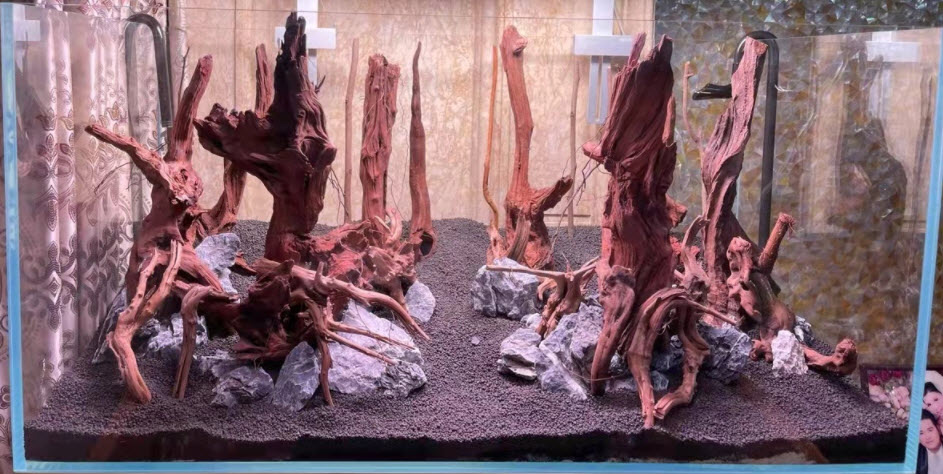
.
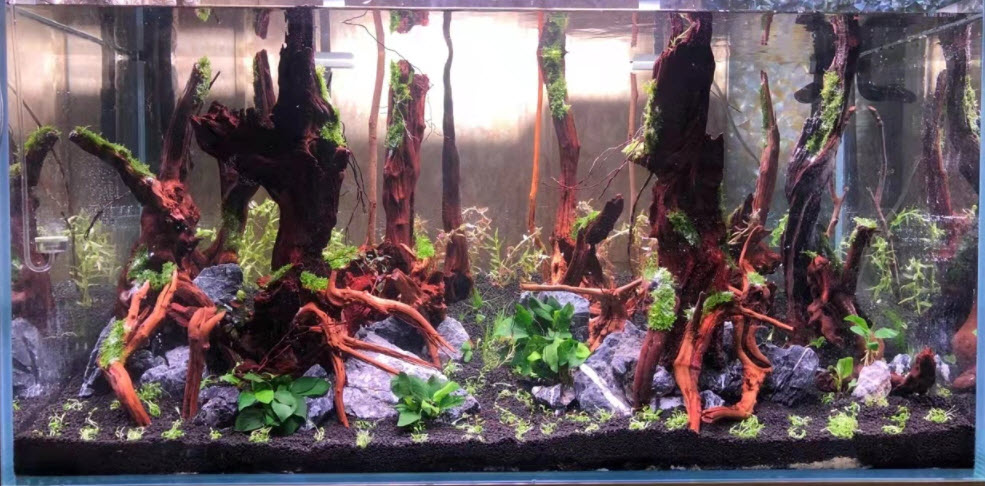
This stage 2 is the important stage!
At this stage one HAS to completely carpet the aquarium with plants. Look at how the aquarium above is planted. It has a plant in every nook and cranny. In the photo sequence below one can see how this prolific use of plants can result in an algae free, beautiful planted aquarium.
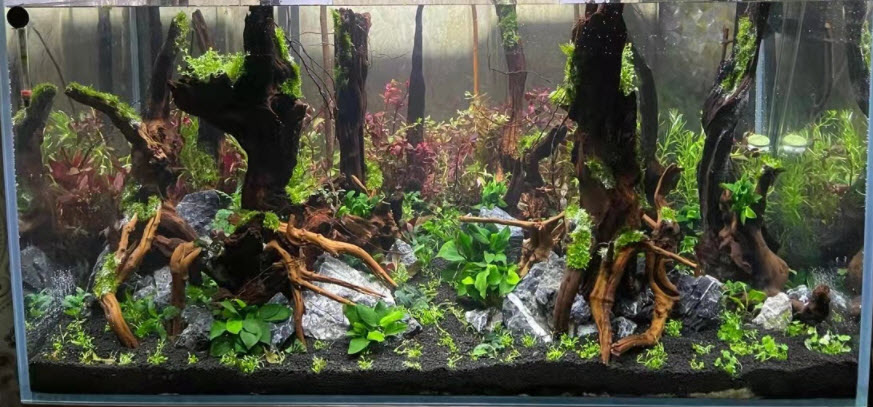
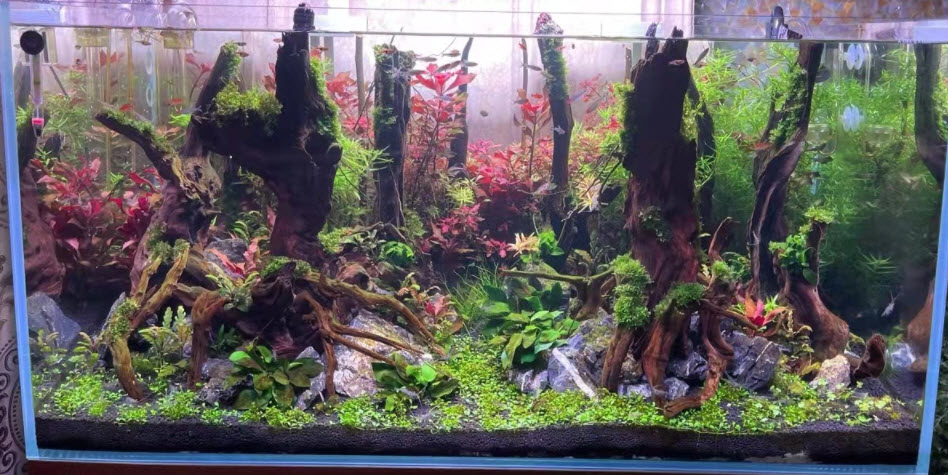
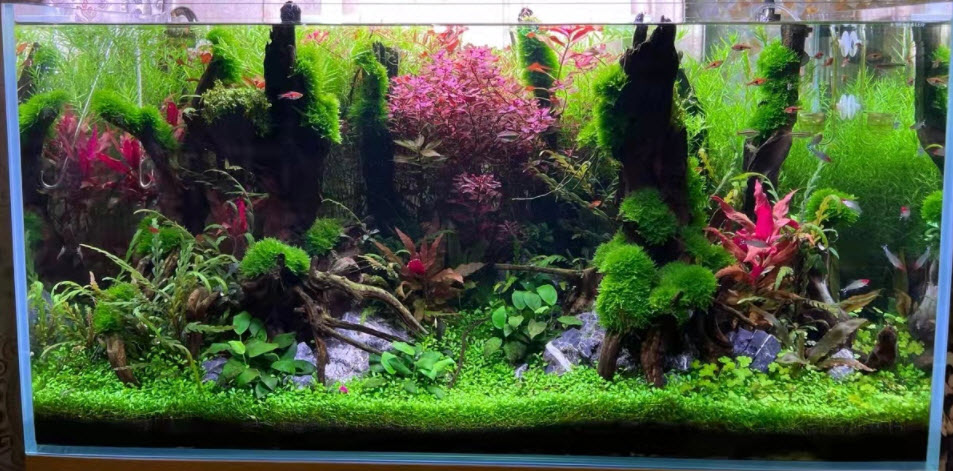
Notice how the plants are covering everything at a spacing of about three inches in the important stage 2. The result is simply stunning. There is NO algae apparent!
I have photos of hundreds of very beautiful mature planted aquariums, both high tech and low tech. Easily 80% of them have vascular plants in every corner of the aquarium. You rarely see algae free plants where only one third of the aquarium is planted.
The only tanks where I see limited plants growing well are either Walstad Tanks that have been around for years (and Ms. Walstad warns you that you will have to live with some algae) or else “native aquariums” which have snails and algae eating fish in them. The leaves of the “native aquarium” plants have lots of algae in the nooks and crevasses, obviously the leaves are being kept clean by snails and algae eating fish.
Personally I think vascular plants put out a lot of toxins with very short “half lives”. These toxins might only exist in aquarium water for seconds. Finding such short lived toxins would require some very expensive studies They need to do DNA sequencing to hunt for genes which produce the toxins involved. Planted aquariums are not exactly a billion dollar industry so no one is going to do those expensive studies.
If one looks closely at the rocks in this high tech planted aquarium you will see they have some green algae on them. But look at the area circled in red. The three inches of rock closest to the Java Fern has no green algae. Hhhhhmmmm…….

A Hypothetical Case Study
Let’s see if we can illustrate the process here. The process also has to do with how quickly vascular plants and algae grow. Algae grow very rapidly. Vascular plants grow much slower. So imagine for a minute an aquarium where the left third of the tank is the only area with vascular plants. These vascular plants have just been planted.
In the right third of the aquarium algae can freely grow, which they proceed to do at a rapid rate. After a few weeks the vascular plants get over their initial shock and start growing and putting out algae toxins. But the toxins do not reach to the right side of the aquarium. So at about four weeks the algae really get going good and putting out spores literally by the millions. The huge number of spores float over to the other side of the aquarium and overwhelm the toxins from the vascular plants. And the vascular plants are smothered and die.
Now imagine for a minute an aquarium where entire tank is planted with vascular plants. Initially some algae begin to grow here and there. After a few weeks the vascular plants get over their initial shock and start growing and putting out algae toxins. And the toxins reach everywhere in the aquarium because the vascular plants are evenly spaced. And the algae can’t get a foothold. And the vascular plants then thrive, further killing off the algae
The few sparse plants in the aquarium below have already started to die and will probably soon be coated in algae:

If one really wants plants with their fish there are some plants which are the exception and simply can’t be killed and which seem to live under any and all conditions. While they will get some algae on their leaves the leaves are resistant to being smothered by algae. And they seem to live in all substrates under all conditions with no fertilizer at all. They even live with very low light conditions.
These plants include Anubias (just don’t put the bulbs INTO the substrate), Amazon Sword (Echinodorus amazonicus), Java Fern (Leptochilus pteropus, synonym Microsorum pteropus), and Java Moss (Taxiphyllum barbieri). Java fern and Java moss are both “epiphytes” and need to be either attached to a surface like a piece of wood or they need a very open substrate like aquarium gravel. If you bury the crown on Java fern in sand it will die.
More Information on Controlling Algae
There is a lot more information on how to control algae in these links:
16.2. Controlling Algae in the Aquarium
16.2.1. Controlling Algae in the Fish Only Aquarium
16.2.2. Controlling Algae in the “High-Tech” Planted Aquarium
16.2.3. Controlling Algae in the “Low-Tech” Planted Aquarium
16.2.4. Algae Eaters
16.2.6. Chemical Control of Aquarium Algae
Return to Algae Menu
.
Aquarium Science Website
The chapters shown below or on the right side in maroon lead to close to 400 articles on all aspects of keeping a freshwater aquarium. These articles have NO links to profit making sites and are thus unbiased in their recommendations, unlike all the for-profit sites you will find with Google. Bookmark and browse!
.

Leave a Reply